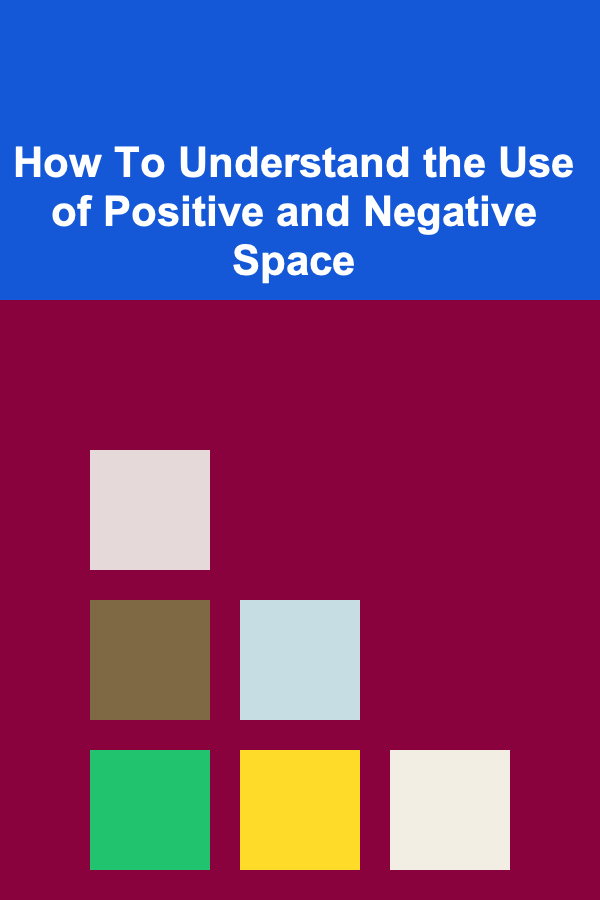
How To Understand the Use of Positive and Negative Space
ebook include PDF & Audio bundle (Micro Guide)
$12.99$11.99
Limited Time Offer! Order within the next:

The concepts of positive and negative space are fundamental in visual arts, design, photography, architecture, and many other creative fields. These terms describe the relationship between the subject and the surrounding area in an image or composition. Understanding how to use positive and negative space effectively is a key skill for creating visually balanced and engaging work. This article explores these concepts in depth, highlighting their significance, usage, and impact on visual communication.
What is Positive and Negative Space?
Before diving into their use, it's crucial to define positive and negative space:
- Positive Space refers to the areas of a composition that are occupied by the main subject or objects. It is the "thing" that grabs the viewer's attention.
- Negative Space is the area around and between the positive elements. It is often referred to as "empty space" or "white space," though it doesn't have to be white. Negative space is just as important as positive space because it helps to define and highlight the positive elements.
These two components are not separate entities; rather, they work together to create a cohesive visual experience. The balance between positive and negative space can dramatically influence the composition's aesthetic appeal, clarity, and meaning.
The Importance of Positive and Negative Space
1. Visual Balance
A well-balanced composition uses both positive and negative space to guide the viewer's eye. Too much positive space can make an image feel crowded or chaotic, while too much negative space can make the composition seem incomplete or disjointed. The key is to find a harmonious balance that feels natural and intentional.
In design and photography, the effective use of space can direct attention to certain areas, guide the viewer's perception, and enhance the overall visual flow. This principle of balance is one of the cornerstones of visual composition.
2. Clarity and Focus
Negative space often acts as a visual rest area for the viewer. It helps isolate the positive elements, making them stand out more clearly. When used effectively, negative space can add depth and emphasize the focal point of a composition.
For example, in photography, a subject placed against a simple background with ample negative space can draw attention to the subject, making it the clear focus of the image. This allows the viewer to appreciate the subject in greater detail without being distracted by unnecessary elements in the background.
3. Visual Hierarchy
In graphic design and other forms of visual art, positive and negative space help establish a clear visual hierarchy. Negative space can guide the viewer's eye to the most important aspects of the composition. By manipulating the amount of negative space around key elements, artists and designers can control the viewer's attention and convey the intended message more effectively.
A well-defined visual hierarchy is especially important in fields like advertising and branding, where the goal is to communicate a message or sell a product quickly. Negative space can highlight the most crucial information, ensuring that it stands out and is easily recognizable.
4. Evoking Emotions
The balance between positive and negative space can also evoke different emotional responses. For instance, a composition with a large amount of negative space can evoke feelings of calm, solitude, or minimalism, while a composition with minimal negative space can feel crowded, energetic, or chaotic. The emotional tone of an artwork or design is often influenced by the way space is used.
For example, in modern minimalist design, the use of vast amounts of negative space can convey sophistication, luxury, and clarity. On the other hand, excessive positive space can give a sense of busyness, creating a more dynamic or tense atmosphere.
Techniques for Using Positive and Negative Space
1. The Rule of Thirds
One of the most commonly used techniques in photography and visual composition is the Rule of Thirds. This rule divides an image into a grid of nine equal parts using two horizontal and two vertical lines. The intersections of these lines are considered points of interest where the key elements of the composition should be placed. The surrounding spaces can then be used as negative space to balance the image.
By placing your subject at one of the intersection points, you allow negative space to surround the subject, which can draw attention to it while maintaining a sense of visual harmony.
2. Framing with Negative Space
Framing is a technique where the subject is surrounded or partially enclosed by negative space or other elements of the composition. This could be achieved through natural elements like trees or windows, or through the strategic use of empty areas in the composition.
Framing with negative space not only helps isolate the subject but also adds depth to the image, creating a sense of dimension. It allows the viewer to experience the subject in relation to its environment, rather than just as an isolated entity.
3. Gestalt Principles
Gestalt psychology explores how the human mind perceives groups of objects and shapes as a whole rather than individual components. Several principles of Gestalt psychology, such as proximity , similarity , and closure, can be used to manipulate positive and negative space in a composition.
- Proximity refers to the idea that objects placed close together are perceived as related. Negative space between these objects can help define their relationship.
- Similarity suggests that objects that are similar in color, shape, or size are perceived as belonging together. Negative space can create contrast between these similar objects, allowing them to stand out.
- Closure occurs when the mind fills in missing information to create a complete image. By using negative space effectively, you can suggest the shape or form of an object without fully outlining it, prompting the viewer's mind to complete the image.
4. Symmetry and Asymmetry
Symmetry and asymmetry are often used to create balance and contrast in compositions. Symmetrical compositions tend to be more traditional and stable, with positive and negative space balanced equally on both sides. Asymmetrical compositions, on the other hand, can create tension, excitement, and energy by using negative space strategically to balance uneven positive elements.
Both approaches can be used to evoke different moods or responses from the viewer. Symmetry is often seen as harmonious and calming, while asymmetry can create a sense of movement or unease.
5. Minimalism and Simplicity
In minimalistic design and art, the focus is placed on reducing the elements to their simplest form. By using a significant amount of negative space, minimalistic compositions highlight the beauty of simplicity and allow the positive elements to stand out without distraction.
Minimalism isn't just about stripping away elements; it's about creating intentional space that serves to emphasize what's important. The use of negative space in minimalist design encourages the viewer to focus on the essential aspects of the composition, evoking a sense of clarity and elegance.
The Role of Positive and Negative Space in Different Disciplines
1. In Photography
Photography is one of the most straightforward areas where the concepts of positive and negative space can be observed. Photographers often use negative space to give context to the subject and guide the viewer's attention. A well-composed photograph uses negative space to create depth, isolate the subject, and evoke the desired emotional response.
For example, a portrait might be composed with the subject off-center, allowing the background or surrounding area to act as negative space. This draws attention to the subject while simultaneously giving the viewer a sense of place or environment.
2. In Graphic Design
Graphic design relies heavily on the manipulation of positive and negative space. Logos, advertisements, and websites all use space to direct attention and convey meaning. A logo, for example, may use negative space to create a secondary image or message, as seen in the famous FedEx logo, where the space between the "E" and "x" forms an arrow.
In web design, the strategic use of white space is essential for readability and user experience. A cluttered website with too much text or too many images can overwhelm the user, while a clean, well-spaced design allows for easy navigation and a pleasant experience.
3. In Fine Arts
In fine arts, especially painting and sculpture, positive and negative space are used to create depth, perspective, and balance. In two-dimensional works, negative space can be used to frame a subject or add visual interest. In sculpture, negative space is just as important as the physical form, as the empty areas around the sculpture define its shape and volume.
Artists like M.C. Escher are known for playing with positive and negative space to create mind-bending optical illusions that challenge the viewer's perception. By flipping the relationship between positive and negative space, Escher invites the viewer to see two different images within a single composition.
4. In Architecture
Architecture is another discipline where positive and negative space plays a significant role. The design of a building or public space is not only about the physical structures (positive space) but also the empty spaces between them (negative space). Courtyards, atriums, and open areas between buildings can serve as negative space that enhances the functionality and aesthetic appeal of the environment.
In modern architecture, the use of negative space can create a sense of openness and transparency. Buildings with large glass windows or open-floor plans utilize negative space to create a feeling of connection with the outside world, while still providing functional areas within the structure.
Conclusion
Understanding the use of positive and negative space is essential for anyone involved in visual composition. Whether you're a photographer, designer, architect, or artist, mastering the balance between positive and negative space allows you to create work that is visually engaging, emotionally resonant, and communicative.
Through thoughtful manipulation of space, artists and designers can direct attention, create focus, and evoke emotional responses. Negative space is not simply empty or unused; it is an integral part of the composition that works in concert with positive space to create harmony and balance.
By incorporating these principles into your work, you can enhance your compositions, create a more dynamic visual experience, and ultimately communicate more effectively with your audience.

How to Choose the Right Argos Floor Lamps for Your Living Space
Read More
How to Find the Best Office Chair for Comfort and Support
Read More
How to Maintain Your Home's Fire Extinguishers and Smoke Alarms
Read More
How to Organize Your Child's School Year Supplies
Read More
How to Turn Your Attic Into Usable Space
Read More
How to Use Plants and Greenery for a Lush Home Staging Look
Read MoreOther Products

How to Choose the Right Argos Floor Lamps for Your Living Space
Read More
How to Find the Best Office Chair for Comfort and Support
Read More
How to Maintain Your Home's Fire Extinguishers and Smoke Alarms
Read More
How to Organize Your Child's School Year Supplies
Read More
How to Turn Your Attic Into Usable Space
Read More